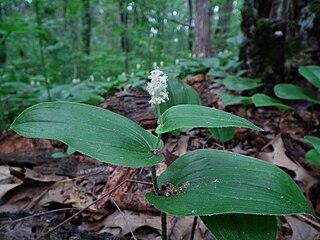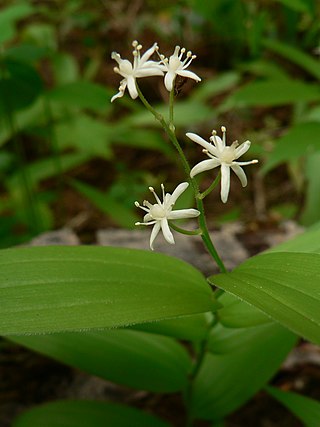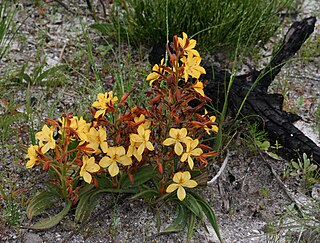
Maianthemum includes the former genus Smilacina and is a genus of perennial herbaceous flowering plants with fleshy, persistent rhizomes. It is widespread across much of North America, Europe and Asia, and may be terrestrial, aquatic or epiphytic. It is characterized by simple, unbranched stems that are upright, leaning or hanging down and have 2–17 foliage leaves. Leaves are simple and may clasp the stem or be short-petiolate. The inflorescence is terminal and either a panicle or a raceme with few to many pedicelate flowers. Most species have 6 tepals and 6 stamens; a few have parts in 4s. Tepals are distinct in most species and all of similar size. Flowers are spreading, cup-shaped or bell-shaped and usually white, but lavender to red or green in some species. Fruits are rounded to lobed berries containing few to several seeds.

Maianthemum canadense is an understory perennial flowering plant, native to Canada and the northeastern United States, from Yukon and British Columbia east to Newfoundland, into St. Pierre and Miquelon. It can be found growing in both coniferous and deciduous forests. The plant appears in two forms, either as a single leaf rising from the ground with no fruiting structures or as a flowering/fruiting stem with two to three leaves. Flowering shoots have clusters of 12–25 starry-shaped, white flowers held above the leaves.

Maianthemum racemosum, the treacleberry, feathery false lily of the valley, false Solomon's seal, Solomon's plume or false spikenard, is a species of flowering plant native to North America. It is a common, widespread plant with numerous common names and synonyms, known from every US state except Hawaii, and from every Canadian province and territory, as well as from Mexico.

Wachendorfia is a genus of perennial herbaceous plants that is assigned to the bloodroot family. The plants have a perennial rootstock with red sap. From the rootstock emerge lance- or line-shaped, sometime sickle-shaped, pleated, simple leaves set in a fan, that are flattened to create a left and right surface rather than an upper and lower surface. The leaves die when the seeds are shed in three of the species, and are perennial in one species.

Pinguicula conzattii is an insectivorous plant of the genus Pinguicula native to the Mexican state of Oaxaca, a member of the section Heterophyllum. Closely related to Pinguicula mirandae, it is notable for being pubescent on both sides of its winter leaves. It is named in honour of Cassiano Conzatti, an Italian-born botanist who spent most of his life in Mexico.

Maianthemum stellatum is a species of flowering plant, native across North America. It has been found in northern Mexico, every Canadian province and territory except Nunavut, and every US state except Hawaii and the states of the Southeast. It has little white buds in the spring, followed by delicate starry flowers, then green-and-black striped berries, and finally deep red berries in the fall.
Furcraea niquivilensis is a plant species native to Chiapas, Mexico.

Maianthemum paniculatum is a perennial flowering plant; a species of monocot found from Mexico to Panama. It is often associated with montane environments and is found primarily in forest openings and along roadsides.

Xochiquetzallia is a genus of geophytic flowering plants of the subfamily Brodiaeoideae in the family Asparagaceae. The genus contains four species: three previously classified within the genus Dandya and one other previously classified within Milla. Earlier genetic and morphological research had shown that the broad Milla clade of plants is made up of two sister lineages. The four plant species now within Xochiquetzallia make up one of these lineages, and are more closely related to each other than they are to the second lineage, which is made up of the remaining Milla species, Dandya purpusii, and the genera Behria, Bessera, Jaimehintonia and Petronymphe. Jorge Gutiérrez and Teresa Terrazas, two of the botanists who worked on the earlier research, followed up in 2020 with a paper formally transferring the four species from Dandya and Milla to Xochiquetzallia.
Maianthemum amoenum is a perennial flowering plant, growing as an epiphyte on trees in cloud forests from Mexico south to Honduras.
Maianthemum monteverdense is a perennial flowering plant of restricted distribution. It grows as an epiphyte on trees in high cloud forests of 1600 m + elevation from Nicaragua to Costa Rica.

Maianthemum gigas is a perennial flowering plant. It is found in Mexico and Central America, growing in forest openings and along roadsides or sometimes as an epiphyte on trees.
Maianthemum paludicola is a perennial flowering plant. It is a rare terrestrial herb, endemic to Costa Rica. It has only been found in high-elevation bogs and wetlands and was first described in 1986.
Maianthemum macrophyllum is a perennial flowering plant. It is a rare epiphtic herb endemic to Veracruz and Oaxaca, Mexico and is known only from primary cloud forests, usually growing on limbs of oaks or sweetgum.

Maianthemum scilloideum is a perennial flowering plant. It is a terrestrial forest herb from southern Mexico and Guatemala and also reported from Honduras.
Maianthemum flexuosum is a perennial, terrestrial understory herb of cloud forests from southern Mexico to Nicaragua. It has been found at sites from 1300 to 2800 m elevation.
Maianthemum salvinii is a rare perennial, epiphytic herb found in southern Mexico and Guatemala.
Maianthemum comaltepecense is a rare perennial, terrestrial herb found as an understory species in moist forests and endemic to southwest Mexico.

Wachendorfia paniculata is a species of plant of 10–90 cm (3.9–35.4 in) high, that emerges during the winter from an underground rootstock. It has entire, sword-shaped, mostly hairy, line- to lance-shaped, straight or sickle-shaped leaves, set in a fan at ground level with a lax to dense panicle consisting of pale apricot to yellow mirror-symmetric flowers with six tepals, three stamens and a undivided style that curves either to the right or left. The species is assigned to the bloodroot family. Flowering occurs between August and December at sea level, and until early February at high altitude, with a distinct peak from September to November. It can only be found in the Cape provinces of South Africa. Like other species of Wachendorfia, it is called butterfly lily in English and rooikanol or spinnekopblom in Afrikaans, and this species in particular is also called koffiepit in Afrikaans.

Beaucarnea hiriartiae is a plant in the family Asparagaceae, native to Mexico. The species is named for the botanist Patricia Hiriart Valencia.











